In certain situations, the rate at which a thing grows or decreases is proportional to the amount present.
When a substance undergoes radioactive decay, the release of decay particles precipitates additional decay as the particles collide with the atoms of the substance. The larger the mass, the larger the number of collisions per unit time.
Consider a collection of organisms growing without environmental constraints. The larger the population, the larger the number of individuals involved in reproduction --- and hence, the higher the reproductive rate.
Let P be the amount of whatever is being measured --- the mass of the radioactive substance or the number of organisms, for example. Let t be the time elapsed since the measurements were started. Then
![]()
If ![]() , then P increases with time ( exponential growth); if
, then P increases with time ( exponential growth); if ![]() , then P decreases with time ( exponential decay). k is called the growth constant (or decay
constant).
, then P decreases with time ( exponential decay). k is called the growth constant (or decay
constant).
I'll solve for P in terms of t using separation of variables. First, formally move the P's to one side and the t's to the other:
![]()
Integrate both sides and solve for P:
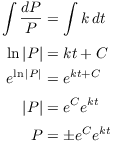
Let ![]() . This gives
. This gives
![]()
Note that ![]() is the initial amount:
Setting
is the initial amount:
Setting ![]() ,
, ![]() .
.
Example. A population of roaches grows exponentially under Calvin's couch. There are 20 initially and 140 after 2 days. How many are there after 14 days?
If P is the number of roaches after t days, then
![]()
When ![]() ,
, ![]() :
:
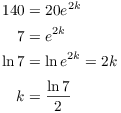
Hence,
![]()
When ![]() ,
,
![]()
Remark. We'll often have expressions of the
form "![]() ",
and this can be inconvenient to write if "stuff" is
complicated. You can use the exponential
function notation to avoid this problem:
",
and this can be inconvenient to write if "stuff" is
complicated. You can use the exponential
function notation to avoid this problem:
![]()
For instance, in the last example,
![]()
Example. A population of MU flu virus grows in such a way that it triples every 5 hours. If there were 100 initially, when will there be 1000000?
Let N be the number of the little rascals at time t. Then
![]()
Since the amount triples in 5 hours, when ![]() ,
, ![]() :
:

Hence,
![]()
Set ![]() :
:
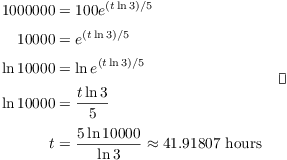
The half-life of a radioactive substance is
the amount of time it takes for a given mass M to decay to ![]() . Note that in radioactive decay, this time
is independent of the amount M. That is, it takes the same
amount of time for 100 grams to decay to 50 grams as it takes for
1000000 grams to decay to 500000 grams.
. Note that in radioactive decay, this time
is independent of the amount M. That is, it takes the same
amount of time for 100 grams to decay to 50 grams as it takes for
1000000 grams to decay to 500000 grams.
Example. The half-life of radium is 1620 years. How long will it take 100 grams of radium to decay to 1 gram?
Let M be the amount of radium left after t years. Then
![]()
When ![]() ,
, ![]() :
:
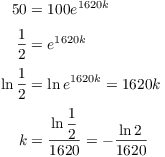
Hence,
![]()
Set ![]() :
:

Example. A population of bacteria grows exponentially in such a way that there are 100 after 2 hours and 750 after 4 hours. How many were there initially?
Let P be the number of bacteria at time t. Then
![]()
There are 100 after 2 hours:
![]()
There are 750 after 4 hours:
![]()
I'll solve for k first. Divide the second equation by the first:
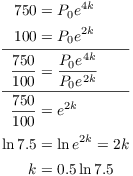
Plug this into the first equation:
![]()
There were 13 bacteria initially (if I round to the nearest
bacterium).![]()
Newton's Law of Cooling.
According to Newton's law of cooling, the rate at which a body heats up or cools down is proportional to the difference between its temperature and the temperature of its environment.
If T is the temperature of the object and ![]() is the temperature of the environment, then
is the temperature of the environment, then
![]()
If ![]() , the object heats up (an oven). If
, the object heats up (an oven). If ![]() , the object cools down (a refrigerator).
, the object cools down (a refrigerator).
I'll solve the equation using separation of variables. Formally move the T's to one side and the t's to the other, then integrate:
![]()
![]()
Let ![]() :
:
![]()
Let ![]() be the initial temperature --- that is, the
temperature when
be the initial temperature --- that is, the
temperature when ![]() . Then
. Then
![]()
Thus,
![]()
Example. A ![]() bagel is placed in a
bagel is placed in a ![]() room to cool. After 10 minutes, the bagel's
temperature is
room to cool. After 10 minutes, the bagel's
temperature is ![]() . When will its
temperature be
. When will its
temperature be ![]() ?
?
In this case, ![]() and
and ![]() , so
, so
![]()
When ![]() ,
, ![]() :
:
![]()
Hence,
![]()
Set ![]() :
:
![]()
![]()
Example. A pair of shoes is placed in a ![]() oven to bake. The temperature is
oven to bake. The temperature is ![]() after 10 minutes and
after 10 minutes and ![]() after 20 minutes. What was the initial
temperature of the shoes?
after 20 minutes. What was the initial
temperature of the shoes?
I set ![]() in
in ![]() to obtain
to obtain
![]()
When ![]() ,
, ![]() :
:
![]()
When ![]() ,
, ![]() :
:
![]()
Divide ![]() by
by ![]() and solve for k:
and solve for k:
![]()
Plug this back into ![]() and solve for
and solve for ![]() :
:
![]()
![]()
![]()
In the real world, things do not grow exponentially without limit. It's natural to try to find models which are more realistic.
Logistic Growth.
The logistic growth model is described by the differential equation
![]()
P is the quantity undergoing growth --- for example, an animal population --- and t is time. k is the growth constant, and the constant b is called the carrying capacity; the reason for the name will become evident shortly.
Notice that if P is less than b and is small compared to b, then ![]() . The equation becomes
. The equation becomes ![]() , which is exponential growth.
Notice that the derivative
, which is exponential growth.
Notice that the derivative ![]() is positive, so P
increases with time.
is positive, so P
increases with time.
If P is greater than b, then ![]() is negative, so the
derivative
is negative, so the
derivative ![]() is negative. This means that P
decreases with time.
is negative. This means that P
decreases with time.
It's possible to solve the logistic equation using separation of variables, though it will require a little trick (called a partial fraction expansion).
Separate the variables:
![]()
Now
![]()
(You can verify that this is correct by adding the fractions on the right over a common denominator.) Therefore, I have
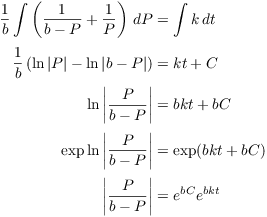
I can replace the ![]() 's with a
's with a ![]() on the right, then set
on the right, then set ![]() . This yields
. This yields
![]()
Now some routine algebra gives
![]()
Divide the top and bottom by ![]() , and set
, and set ![]() :
:
![]()
Suppose the initial population is ![]() . This means
. This means ![]() when
when ![]() :
:
![]()
Thus, the equation is

For example, consider the case where ![]() and
and ![]() . I've graphed the equation
for P with
. I've graphed the equation
for P with ![]() , 1, 2, 3, 4, and 5:
, 1, 2, 3, 4, and 5:
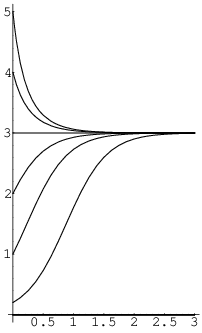
![]() shows initial exponential growth. As the
population increases, growth levels off, approaching
shows initial exponential growth. As the
population increases, growth levels off, approaching ![]() asymptotically.
asymptotically.
![]() and
and ![]() are already large enough that the
population spends most of its time levelling off, rather than growing
exponentially.
are already large enough that the
population spends most of its time levelling off, rather than growing
exponentially.
An initial population ![]() remains constant.
remains constant.
![]() and
and ![]() yield populations that shrink, again
approaching
yield populations that shrink, again
approaching ![]() as
as ![]() .
.
You can see why b is called the carrying capacity. Think of it as the maximum number of individuals that the environment can support. If the initial population is smaller than b, the population grows upward toward the carrying capacity. If the initial population is larger than P, individuals die and the population decreases toward the carrying capacity.
Copyright 2018 by Bruce Ikenaga